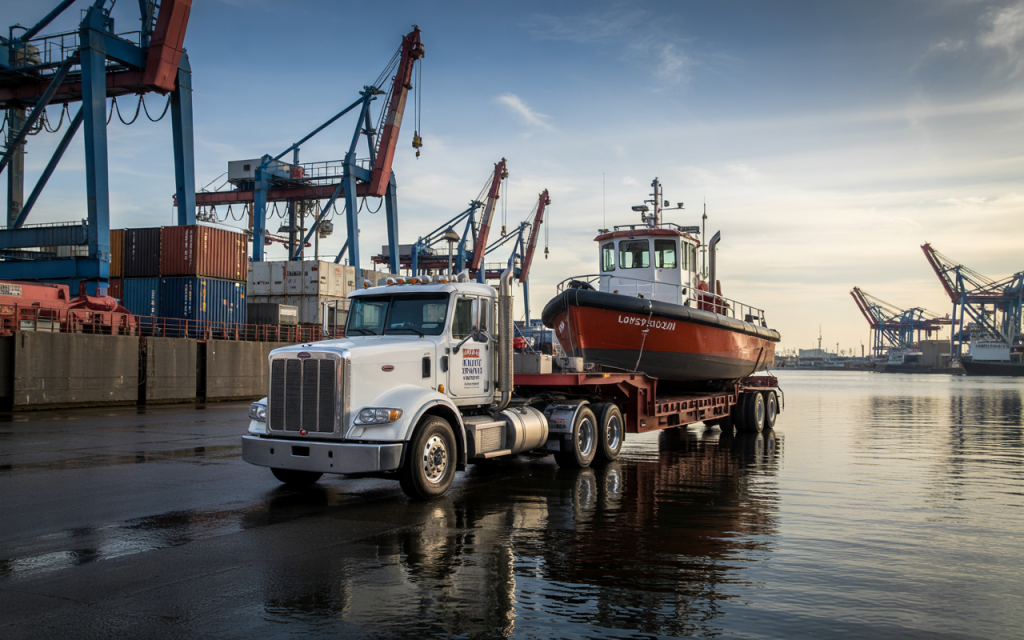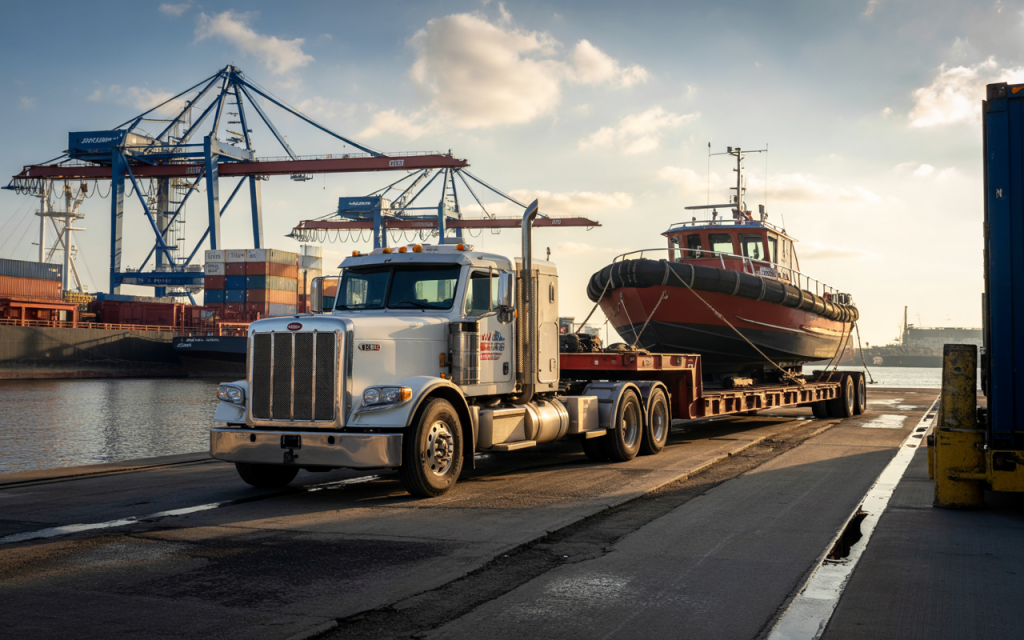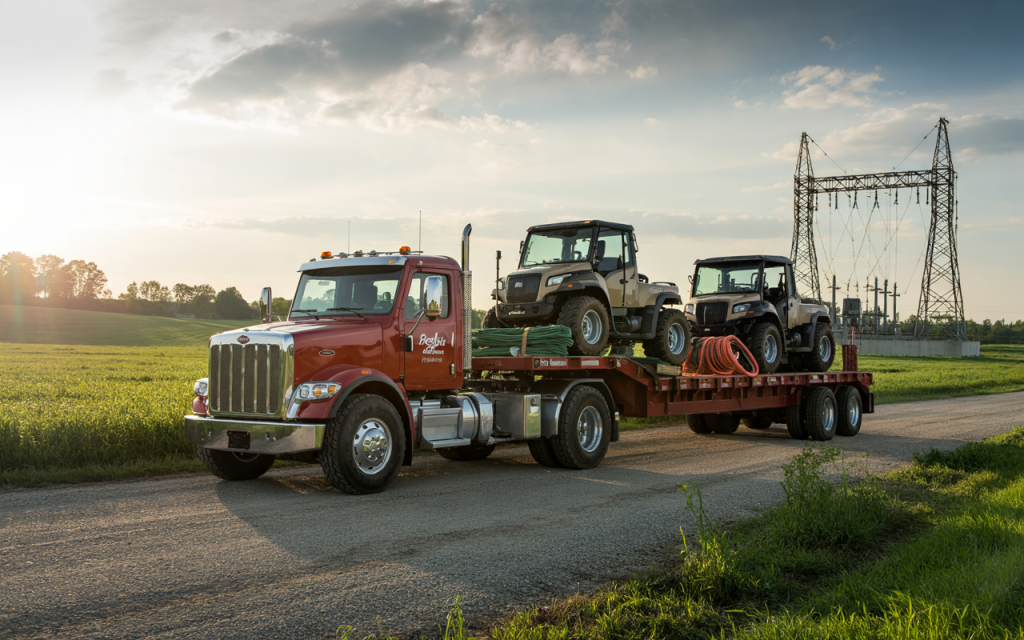How We Plan Heavy Haul Trucking Routes in Maine Safely and Legally
Freedom Heavy Haul can offer expedited Pickup and Delivery for any size shipment anywhere in the USA. Contact us today for No Hassle, No Pressure Pricing.
To move heavy or oversized loads in Maine, we carefully plan every mile of the route to avoid violations, delays, and damage. It’s not just about finding a route on a GPS—it’s about how we manage the entire process to meet state regulations, adapt to road conditions, and ensure safety.
In this article, you will learn about How We Plan Heavy Haul Trucking Routes in Maine.
What We Consider a Heavy Haul Load in Maine
In Maine, a load is considered heavy haul if it exceeds any of the following:
- 80,000 pounds in total weight
- 8 feet 6 inches in width
- 13 feet 6 inches in height
- 53 feet in trailer length
If we’re transporting wind turbine blades, construction equipment, or similar oversized items, it’s our responsibility to treat the job as a heavy haul operation from the start.
How We Handle Permits and Legal Compliance
We never move oversized freight without first obtaining the required permits. Depending on the specifics of the load, we apply for:

- Single Trip Permits – for one-time shipments on a specific route
- Annual Permits – for routine routes with similar cargo
- Special Review Permits – for loads over 125,000 pounds or with unusual dimensions
We submit detailed information during the application process, including cargo weight, dimensions, axle configuration, and proposed route. We begin this process several days in advance to avoid last-minute delays.
Agencies We Coordinate With
Every oversized haul in Maine must comply with multiple authorities. We coordinate with:
- Maine Department of Transportation (MaineDOT) for road access and permits
- Bureau of Motor Vehicles (BMV) for vehicle specs and documentation
- Local municipalities for town-specific road use and clearances
- Maine State Police, especially for multi-county travel or night hauls
If the route includes any special challenges, we also work directly with utility companies to adjust power lines or signage.
How We Avoid Infrastructure Hazards
Not every road in Maine can handle an oversized load. That’s why we carefully assess each route for:

- Weight-restricted bridges that may require engineering review or rerouting
- Low-clearance overpasses that can block tall loads
- Narrow or rural roads that may be unsafe for wide trailers
We use MaineDOT’s online GIS system and other verified tools to identify risks in advance and reroute if necessary.
How We Adjust for Seasonal Conditions
Maine’s climate creates seasonal restrictions that we always factor into route planning:
- Spring Load Restrictions (March through May) limit axle weights on thawing roads
- Snow and ice in winter can make rural roads inaccessible or unsafe
- Coastal weather may bring fog or high winds that impact visibility and stability
If a planned route is impacted by seasonal conditions, we modify our schedule or choose alternate paths to protect the cargo and comply with state limits.
Our Strategy for Route Selection and Optimization
We don’t just choose the shortest or fastest route—we plan the most practical one. We focus on:

- Roads that are approved and structurally safe for our vehicle and cargo
- Turnaround and emergency pullover spots
- Access to repair services and rest areas on longer hauls
- Time-of-day travel restrictions and required escorts
We always balance efficiency with compliance, safety, and equipment longevity.
Local and Interagency Coordination
It’s our job to ensure that all town-specific regulations are followed. For example:
- Some towns require advance notice or special travel permits
- Extremely wide or tall loads may require police escorts
- If wires or traffic signs need to be moved, we arrange that with the utility company in advance
Overlooking even a small local rule can cause delays. That’s why we manage every detail proactively.
Route Planning Tools We Use
Our logistics team relies on a combination of experience and digital tools to get it right. These include:
- ProMiles and Rand McNally for route generation
- MaineDOT’s GIS Viewer to assess bridge and road data
- Real-time fleet tracking systems to monitor load progress
- Axle weight calculators to ensure compliance throughout the trip
These tools reduce risk and help us stay on schedule.
Safety Protocols We Follow
Safety is built into every phase of our heavy haul planning. Before the load even moves, we ensure:
- Escort or pilot vehicles are scheduled and ready
- Load securement is verified and documented
- All signs, lights, and indicators are in place
- Drivers are briefed on the safety plan and emergency protocols
We take these steps seriously to avoid accidents and ensure everyone on the road stays safe.
Frequently Asked Questions about How We Plan Heavy Haul Trucking Routes
Here are some questions and answers:
What size load requires a permit in Maine?
Any load over 80,000 pounds, 8 feet 6 inches wide, 13 feet 6 inches tall, or 53 feet long requires a permit.
How do I get a heavy haul permit in Maine?
We apply through MaineDOT with full details about the cargo, route, and axle layout. Permits typically take 1 to 5 business days.
Are there roads I can’t use during spring in Maine?
Yes. Maine enforces seasonal weight restrictions in spring to protect thawing roads. We always check the latest restrictions before finalizing the route.
Can oversized loads travel at night?
Yes, but only with special approval and appropriate escorts. We schedule night hauls only when necessary and ensure all conditions are met.
Who moves the power lines if the load is too tall?
We coordinate with the utility company ahead of time. This is handled as part of our planning process.
If you’re managing an oversized shipment, let us handle the planning. We know how to navigate Maine’s roads, regulations, and weather to ensure your load arrives safely and legally.







